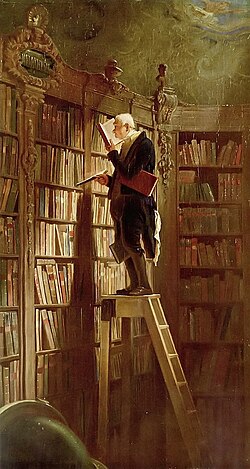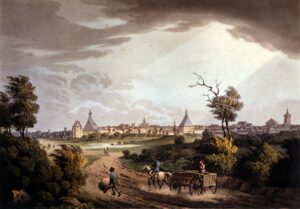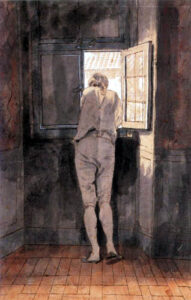This topic is related to my work in Spanish, which deals precisely with parents who devour the souls of their children.
Category: Literature
Snow White
The true story
Wow. What a find. I’ve always thought that fairy tales reflect realities that illustrate what I want to say in my trilogy of books I’m translating into English—and look what I found today!
In the real Middle Ages, not in fairy tales, some mothers—who we would now say suffered from malignant narcissism—killed their most beautiful daughters for reasons of power, if we understand the dynamics of the noble classes. (I couldn’t help but think of the infanticide campaign that my mother subtly unleashed during my puberty and that virulently culminated in my adolescence. But that’s another story.)
Sixteen
years later (III)
Already flying halfway across the Atlantic on 12 September 2009, I read Justin Raimondo’s article “The Good War Wasn’t So Good”, the first few paragraphs of which were published by TOQ Online:
I write these words on September 3, 2009, seventy years to the day since Britain and France declared war on Germany—an occasion observed, if not exactly celebrated by the leaders and opinion-makers of the West, as the beginning of “the good war.” The War Party just loves WWII because it’s the one war where all agree we had no choice but to fight and win a war to the death. Well, not quite all, but on this question dissent is simply not tolerated.
Take, for example, Pat Buchanan, who marks this anniversary with a reiteration of the theme of his excellent book, The Unnecessary War, which makes the case that war was never inevitable, and that only the pernicious idea of “collective security”—the Franco-British “guarantee” to Poland—made it so. Buchanan also makes the indisputable point that if only the Poles had given Danzig back to Germany, from whom it had been taken in the wake of the disastrous Treaty of Versailles, a negotiated peace would have been the result—a much more desirable one than 56,125,262 deaths and the incalculable toll taken by the war in terms of resources and pure human misery.
Oh, but no: to the “bloggers,” left and right, this is a case of “Pat Buchanan, Hitler Apologist.” In the political culture constructed by these pygmies, any challenge to the conventional wisdom—especially one that involves questioning WWII, the Sacred War—is something close to a criminal act, one that separates out the perpetrator from the realm of polite society and consigns him to an intellectual Coventry, where he can do no harm. And of course attacking US entry into WWII is considered a “hate crime” because—well, what are you, some kind of “Hitler apologist”?!
But of course WWII was not inevitable, and Hitler was indeed amenable to negotiations: he never wanted to go to war with the British—whom he admired—and the French, whose influential native fascist movement had good relations with their German co-thinkers.
The article motivated me to obtain a copy of Buchanan’s book. Once settled in Mexico, on 23 September I read Sam G. Dickson’s “A Modest Proposal” in the same webzine which contains these paragraphs:
To those of you who think this is a nutty comment, I would suggest that you attend the next town hall meeting of your local Congressman or Senator. He need not be a liberal, not some crazed Methodist on Marx or a Marxist on meth, like Hillary Clinton. He could be a white Christian Southern conservative Republican Congressman. During the question and answer period, go to the microphone and say: “Congressman, I am concerned about the tide of non-white immigration, and the low white birthrate in this country and around world. I’m concerned that our race might become extinct.”
And just see the reaction of that Christian, Southern, conservative member of the establishment. See how you will be shouted down by his followers. See how the guard will be instructed to come and take you out of the room, because you have committed an act of hate by suggesting that your race should be anything other than exterminated.
It is considered per se immoral to advocate the survival of our race. We need to think about that when weighing the claims of our enemies to be the voices of love and tolerance.
But where do the feelings that it’s immoral to advocate Aryan survival come from? Through my fault, through my fault, through my most grievous fault, which I heard countless times at Mass as a child, only metastasised into the Aryan collective unconscious after the Second World War. As Tom Holland has said both in writing and on YouTube: after WW2, white people managed to maintain Christian ethics only by transferring the idea of the Devil to Adolf Hitler. Because of this transfer, the West now defines morality in a negative way: everything must be done in opposition to Hitler’s ideals!
In other words, after WWII Aryans must commit ethnic suicide. That same day, I read Greg Johnson’s review of the novels of Harold Covington, who had been inspired by The Turner Diaries (the following year, when Johnson launched his new website, Counter Currents, he republished his review which can be read here).
Given that Johnson praised the novels this explains why, in 2009, I, who longed for a revolution, never criticised white nationalism. I imagined it then as a revolutionary ideology, as evident in this comment by Michael O’Meara in TOQ Online regarding Johnson’s review. Incidentally, some TOQ Online articles are still available on the internet. But they no longer have a comments section, so the following gem from O’Meara would have been lost had I not printed it out for my binder sixteen years ago:
This is an extraordinary article on an extraordinary subject. I am constantly amazed by the fact that the Quartet
[H.A. Covington's The Hill of the Ravens, A Distant Thunder, A Mighty Fortress and The Brigade —Ed.]has been virtually ignored in our community. Part of this, I imagine, is due to the fact that the present generation of racialists, like their unconscious cohorts, no longer reads. Anything that’s more than two or three thousand words long and lacks illustrations is practically inaccessible to them.A second reason I imagine the Quartet has been ignored is probably due to Covington himself, who is apparently an uncompromising individual and certainly one who has acquired a great many enemies. I don’t personally know Covington, so I have no way of evaluating the various charges made against him.
[The charges were true. See may take here —Ed.]In any case, even if the nasty things said about him by his enemies are true, it still distracts not in the least from the quality of his works, which are virtually unparalleled in our community. This gets me to the third reason I think the Quartet is ignored. Both white nationalism and race realism are largely cyber phenomena. If you take Covington seriously, however, you would have to tear yourself away from the computer monitor and act in the real world—with all its attendant inconveniences. The thought of political activity, though, is apparently too much for most of us. We too, even if we have remained unmoved by the system’s racial fictions, seem to behave in ways not unlike the rest of the sheep. Will we also go quietly to the slaughter?
I think it’s significant that the spontaneous uprising depicted in the Quartet at Coeur d’Alene, which provoked the war leading to the eventual formation of the Northwest American Republic, was something of a mystery. This rings true to me. We may no longer be the men who defied the might of the British Empire in 1776 or 1916, but there are other forces that might save us from ourselves.
The greatest of the “conservative” thinkers, Joseph de Maistre, pointed out long ago that the French Revolution led the revolutionaries rather than was led by them. For he believed that certain Providential forces rule our lives. These forces he saw in Christian terms, but others, like Heidegger, for instance, saw them in terms of Being, over which humans have no control.
In either case, the force of Providence or Being or Destiny has a power that has often made itself felt in our history. For this reason, I have little doubt that Europeans will eventually throw off the Judeo-liberal system programming their destruction. I’m less confident about we Americans, given the greater weakness of our collective identity and destiny. But nevertheless even we might be saved from ourselves by this force—as long as we do what is still in our power to do. Greg Johnson has given us in this review something we ignore at our own peril.
The tragedy is that, in the years that followed, American white nationalism suffered a regression: from an incipient revolutionary thought to de facto conservatism. Moreover, the revolutionary O’Meara left the movement after a heated discussion thread against the monocausalists of Counter-Currents regarding the JQ.
Sixteen
years later (II)
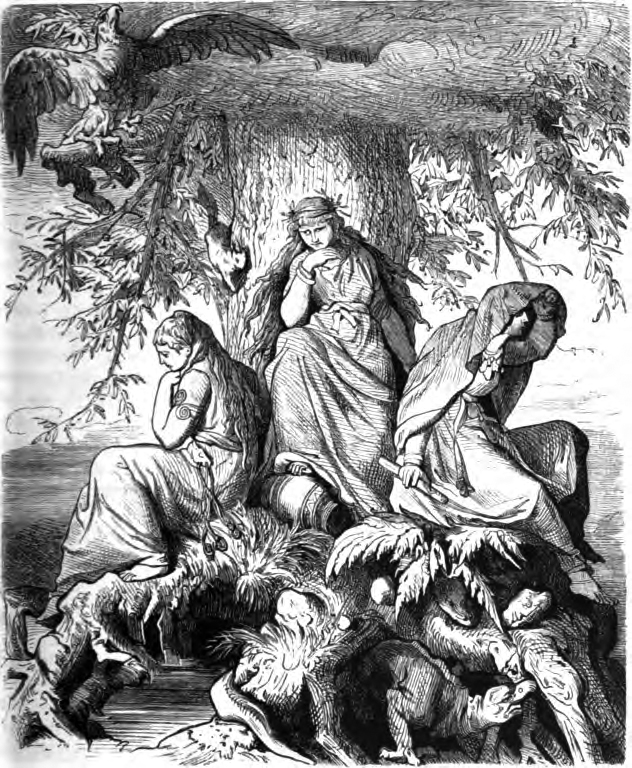
The norns Urðr, Verðandi and Skuld beneath the world tree Yggdrasil (1882) by Ludwig Burger.
I continue to quote some passages from my binder. Incidentally, when it got wet, not only did the ink from my notes run, but it also bled through to the other side of the pages. Fortunately, it is still legible.
______ 卐 ______
Once on the plane, when I no longer wanted to be in Zapatero’s Spain and was preparing to live in Mexico, on 12 September 2009, still on the ground but after midnight, I began to read the articles printed in my binder of The Occidental Quarterly Online (TOQ Online from now on).
The first one I read on the plane was “The Seven Pillars of White Nationalism” by Yggdrasil (I would later learn that this was John Gardner’s pen name). I was stunned to see that among the readings Yggdrasil recommended was Himmler’s Posen Speech!
Unlike what I had been reading in Larry Auster’s View From the Right, the contributors to TOQ Online weren’t Jews. Since I was just beginning to familiarise myself with white nationalist literature, I would not wake up to the Jewish Question until the following year (February 2010, to be exact). But on the plane, still grounded at the Gran Canaria airport, I had no way to awaken to the JQ, and I wrote in the binder something in Spanish that I am now translating. When I came across Yggdrasil’s recommendation of The Protocols of the Learned Elders of Zion, I wrote: “Wow, wow, wow. So these guys are totally paranoid?”
In January 2014, when I reread this article, my old notes and I had already awakened to the JQ, I added a postscript on the same page of the binder: “Look what I thought four years ago… I remember reading this on the plane and feeling that it was an evil trait of the author and of all TOQ in general—just the Pavlovian reaction that everyone who takes a look at my current blog for the first time must feel…”
When I started blogging in 2009, in the first incarnation of The West’s Darkest Hour I hadn’t yet awakened to the JQ, so in 2014 I was referring to the second incarnation of my site; the present one is the third incarnation after WordPress cancelled my account. Incidentally, the Spanish word actual (translated as current) is underlined in my binder; above I put it in italics.
In his article Yggdrasil also recommended The Turner Diaries, a novel I was not yet familiar with, and on the second page of the article on recommended readings, I read this sentence by him:
Surprisingly, I was unable to find any coherent and helpful works in English translation from The Third Reich explaining how National Socialism might save us. Most of the major works of that period, including Rosenberg’s Myth of the Twentieth Century and Hitler’s Mein Kampf are dreadful tomes, which fail to recognize our basic predicament. The best explanation I can find of National Socialism is Lincoln Rockwell’s White Power.
I have complained a lot about this: there is no good book from the Third Reich that explains National Socialism; at most, there are inspirational booklets and, after 1945, Hitler’s readable after-dinner talks that can be read one a day (as David Irving recommended). But during the Third Reich there could be no frank books because that would have meant revealing the profound anti-Christianity of NS. It would have been political suicide to reveal that esoteric aspect to the masses. So, while I do not blame Hitler or his intellectuals for the absence of such an educational book (as Mein Kampf is a dreadful tome as Yggdrasil rightly says), our anthology The Fair Race could now be considered an introductory book (unlike the 1930s, in the new century the esoteric aspect of NS must become exoteric). Yggdrasil continues:
The prosperity that followed WW II has reduced the inclination of Euros to resist the human equality mania en-mass, resulting instead in localized witch hunts, including war crimes persecutions and hate crimes laws.
That is why what I long for most of all is for fiat currencies to collapse and, subsequently, for energy devolution to eliminate billions of Neanderthals. Only then will the degenerative effects of material comfort evaporate, like morning dew, among the surviving whites. Yggdrasil continues:
And you cannot interrupt the flow of social reinforcement by adopting a low status label—by claiming to be a KKK member, for example—just to gain the attention of the media. Adopting emblems and symbols that the controlled media has invested billions of dollars stigmatizing as low status merely serves to reinforce the belief among the outer party that their displays of the egalitarian delusions confer precisely what they seek—the opinion of their neighbors that they are “good people.” Thus, in order to interrupt the status transmission mechanism, the outer party must value your opinion of them. You must appear to be just like them. That means you must avoid markers of low status.
Sixteen years after I read the article, we see that even that isn’t possible in the darkest hour of the West. I have been watching many videos about Charlie Kirk, who was murdered this month by a homo, and it hurts that someone as good as him—good by normie standards—, so incapable of the slightest hatred, was slandered as a hater not only by the murderer but also by the progressives who applauded the attack. So it’s not enough to appear to be a good guy, as Yggdrasil recommended, to prevent crazy people from calling you a Nazi. I prefer to show my true colours: red, white and black so that at least a few visitors will want to become priests of the sacred words (cf. our featured article).
Yggdrasil’s article was published on 6 September 2009. Unfortunately, TOQ Online no longer exists. That’s why it was worth printing the articles that started my ideological transformation.
Those were different times. Online I never, ever insulted White Nationalism at that time! Incidentally, only one brief comment appeared in the comments section, from Michael O’Meara, who subscribed to white nationalism but not to NS. O’Meara commented: “I feel about the world in a way different from Yggdrasil, but at the same time I think every important idea of my WN comes from what I learned from him.”
Greg Johnson was then editor of TOQ Online, and I was surprised to discover in my binder that the previous article Johnson had published in that webzine was titled “All-Time Leading Hitlers”.
As I said, those were different times…
Bibliophile
Hatnote of September 14:
These days (weeks?) I’ll be drying the dozens of soaked books, page by page, with paper towels. I won’t have time to post many entries. My library takes priority because it allows me to write.
______ 卐 ______
Der Bücherwurm is an oil-on-canvas painting by the German painter and poet Carl Spitzweg.
This is an update to my article from earlier this month, “Books”.
Today, I took a taxi to retrieve my flood-damaged books, which were packed in five boxes.
As I said nine days ago, what is really valuable about these books are my countless footnotes. Since I am debating with the authors, they are like intellectual diaries. That is why I plan, to the extent of my modest means (I have already purchased special brushes to remove the mould, a fan, and a heavy-duty dryer), to rescue what I can from the wet books.
It will be an arduous task that will take weeks… This afternoon, for example, I can’t do anything because the sky is already cloudy, and it was rainy. Tomorrow I will start: in this season it very rarely rains in the mornings and the sun is healthy.
It pains me that I won’t be able to recover the glossy paper books, usually the ones with illustrations, because the pages have stuck together; and the home remedies on YouTube no longer work because my books were wet for several weeks (the guy who keeps them at home is a bit deranged and didn’t warn me when a downpour flooded the room with my boxes). I spoke to an institution that is capable of separating those stuck pages, but the cost of that process, with special liquids and chemicals, is so prohibitive that only a multimillionaire could afford it.
The rest is salvageable, but the water managed to erase many of my notes.
Something that alarms me about the new generations of noble Aryans who are conscious of their race is that they do not seem to value books, but rather focus on purely physical activities. Given that the darkest hour of the West is due to the Jewish infection—I am referring to Christianity—which was transmitted by the written word, to defeat that idea requires another written idea (see what Messala said to Sextus). As the Spanish saying goes, Para que la cuña apriete tiene que ser del mismo palo (For the wedge to tighten it has to be of the same suit), i.e., if you want to defeat the Jew and his ideas, you better become a scholar, a bookworm.
On the one hand, I understand these very young Aryans, because most respected human knowledge has nothing to do with 14/88, as LK rightly observed on this site today about people like Stephen Hawking. But keeping the books I have been accumulating for decades is vital because the notes are testimony to a spiritual odyssey. And if I ever have an heir living in my town to whom I can pass on the mantle, he would keep those old books for their biographical value (just as, say, those who preserve the work of William Pierce keep his personal library).
Although I am not a fan of Carl Sagan, I would like to end this post with this clip from Cosmos: A Personal Voyage.
Eureka!
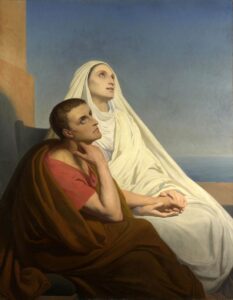 I am not finished with what I recently said about St Augustine. For the faithful, the crucial event in Augustine’s conversion happened when, at random, he picked up an epistle of Paul and read a verse that struck him like a bolt of lightning.
I am not finished with what I recently said about St Augustine. For the faithful, the crucial event in Augustine’s conversion happened when, at random, he picked up an epistle of Paul and read a verse that struck him like a bolt of lightning.
Augustine was the architect of the Dark Ages. It is high time for Daybreak: exactly the opposite regarding the Jesus myth that persists in quite a few quarters of the American racial right.
From the video ‘Bible scholars leave Christianity’ (which is over 10 hours long!), the eureka moment I like the most is this moment of reverse conversion. While reading an ancient ‘pagan’ text, a Bible scholar realised that Evangelists of later times had plagiarized the legends of Jesus from the story of Romulus, the God of the Romans.
Goethe
If Cervantes seems to be the central figure of Spanish literature, Johann Wolfgang von Goethe appears to be the central figure of German literature.
Goethe’s most famous work is Faust, one of the great works of world literature. Its plot reminds us of Satan’s wager with the god of the Jews in the Book of Job. In Goethe’s novel, Mephistopheles makes a pact with God: he says he can divert God’s favourite human being (Faust), striving to learn everything that can be known, away from moral purposes. It also reminds me of the plot of Wagner’s Tannhauser. I have already said on this site that when I first saw the opera I was disappointed because it put Christianity triumphing over paganism (the Virgin Mary over the Goddess Venus). Cervantes and Shakespeare didn’t play into the hands of the Church, and neither did Goethe. But it is clear that like Wagner they never escaped Christian mythology.
I would not like to focus on Goethe’s masterpiece but on what was, at the time, the most popular: The Sorrows of Young Werther (Die Leiden des jungen Werthers): a semi-autobiographical epistolary novel. Considered the book that initiated Romanticism, it brought the young Goethe worldwide fame.
The main character of the novel, Werther, is a sensitive and passionate young man who falls madly in love with Charlotte. In real life, Goethe had fallen in love with a young woman named Charlotte (and in real life, in Manchester, I myself fell in love with a Charlotte who never returned my love!).
So influential was that novel, which Goethe had written in his early twenties, that towards the end of his life travelling to Weimar and visiting the master of German literature was a ritual. In one of his writings Goethe himself mentioned that his youthful suffering was partly the inspiration for the creation of the novel, although unlike the novelist Werther takes his own life at the moment when the midnight bells ring in Wahlheim. Most of the visitors he had in his old age had only read this book and only knew the writer from this novel among all those he wrote! It was very clear what a great impact The Sorrows of Young Werther had on young people in love and depressed.
I wonder what subliminal clues Werther had that a whole generation of young Europeans caught that fever to the point of dressing like the character: with a yellow vest, blue jacket and brown boots. Even some two thousand young Europeans took their own lives! ‘The bullet had entered above the right eye, blowing out the brains’ I read on the penultimate page of the copy of the novel I own. So much did the novel in the form of an epistle catch fire to Europe, that the small town where the fictional events took place became a sort of place of pilgrimage. Napoleon himself carried a copy of Werther in his field backpack!
Already in the 20th century my mother confessed to me that in her early teens this book had made a great impression on her. In my previous article I said that almost all the literary content of the Spanish writers of the Golden Age tasted rancid to me. It is curious to mention what I wrote some years ago on the inside back cover of my copy of Werther (my translation):
Wow!
I barely read the first few words of the book and couldn’t continue. I’d have to see a German film of the novel—if there is one. What matters is that they were committing suicide because ‘In those days parents didn´t listen to their children’, [the words of] Mom.
She didn’t tell me that in relation to Werther, but to a bitter experience she had when she was taken as a child to see The Blue Bird on the big screen: the only occasion, in her entire life, when an indirect criticism of either of her parents came out.
To be frank, I don’t think a teenager who has been treated well by his parents would be capable of committing suicide just because of a love setback. There must something wrong in the lad’s psyche, but to find out we have to dynamite the taboos of the age whose Judeo-Christian commandment to honour the parent has deeply permeated the secular world (Alice Miller has written on this secularization in The Body Never Lies).
That’s why this kind of old literature tastes rancid. Unlike not only the times of Goethe, but the times of my mother (who must have been a little girl when the translated The Blue Bird was released in the country), in this era it is already possible to speak crudely about how we were mistreated at home. So, if the least direct criticism of her parents never came out of my mother’s mouth except for the above quote (which came out indirectly when she was already an old woman), we can imagine on whom she unloaded her pent-up anger. All this has to do with Werther precisely because of the literary genre that I would like people like Benjamin and myself to inaugurate.
The following seven paragraphs I had already posted on this site in January 2015 under the heading ‘New Literary Genre’, but they are worth quoting again:
Stefan Zweig wrote in Adepts in Self-Portraiture that when Western literature began with Hesiod and Heraclitus it was still poetry, and of the inevitability of a decline in the mythopoetic talent of Greece when a more Aristotelian thought evolved. As compensation for this loss, says Zweig, modern man obtained with the novel an approach to a science of the mind. But the novel genre doesn’t represent the ultimate degree of self-knowledge:
Autobiography is the hardest of all forms of literary art. Why, then, do new aspirants, generation after generation, try to solve this almost insoluble problem?
[For a] honest autobiography […] he must have a combination of qualities which will hardly be found once in a million instances. To expect perfect sincerity on self-portraiture would be as absurd as to expect absolute justice, freedom, and perfection here on earth. No doubt the pseudo-confession, as Goethe called it, confession under the rose, in the diaphanous veil of novel or poem, is much easier, and is often far more convincing from the artistic point of view, than an account with no assumption of reserve. Autobiography, precisely because it requires not truth alone, but naked truth, demands from the artist an act of peculiar heroism; for the autobiographer must play the traitor to himself.
Only a ripe artist, one thoroughly acquainted with the workings of the mind, can be successful here. This is why psychological self-portraiture has appeared so late among the arts, belonging exclusively to our own days and those yet to come. Man had to discover continents, to fathom his seas, to learn his language, before he could turn his gaze inward to explore the universe of his soul. Classical antiquity had as yet no inkling of these mysterious paths. Caesar and Plutarch, the ancients who describe themselves, are content to deal with facts, with circumstantial happenings, and never dream of showing more than the surface of their hearts.
Zweig then devotes a long paragraph to St Augustine’s Confessions, the thinker I abhor the most of all Western tradition and whose theology about Hell caused massive psychological damage in my own life (see Hojas Susurrantes). Then he wrote:
Many centuries were to pass before Rousseau (that remarkable man who was a pioneer in so many fields) was to draw a self-portrait for its own sake, and was to be amazed and startled at the novelty of his enterprise. Stendhal, Hebbel, Kierkegaard, Tolstoy, Amiel, the intrepid Hans Jaeger, have disclosed unsuspected realms of self-knowledge by self-portraiture. Their successors, provided with more delicate implements of research, will be able to penetrate stratum by stratum, room by room, farther and yet farther into our new universe, into the depths of the human mind.
This quote explains why I decided to devise a hybrid genre between the self-portraiture that betrays the author and thus penetrates beyond the strata pondered by Romantic autobiographers. And it is precisely because of this that, if we have tried to reach this level, the previous stages of confessional literature already seem rancid to us, Werther included: they don’t get to the heart of the matter.
That said, there are a few biographical vignettes about Goethe that I wouldn’t want to overlook. For example, he dearly loved his sister Cornelia, the only surviving of his siblings (I will allude to this below in the context of Goethe’s own children).
Johann Kaspar, Goethe’s father had been a well-to-do scholar, and the letters of Katharina Elizabeth, his mother are quite readable. Goethe studied in Leipzig in enviable times when machine noises weren’t yet audible (I write this over the intolerable sound of air conditioning given the temperature outside my study):
A similar image could be added about Weimar, where Goethe took up residence after the publication of Werther. It was in the old Weimar court theatre that the first Goethean dramas, that he directed for a quarter of a century, were presented.
The trip to beautiful Italy had been pivotal in Goethe’s education. In the image above we see Goethe at the window of his home in Rome, a drawing by Tischbein. It was a time when St. Peter’s stood as the tallest building in the city. As I have said, it is impossible for a ‘man of his time’ not to be influenced by these architectural realities. And Goethe was, like Dante, Cervantes and Shakespeare, a man of his time. Only Nietzsche would rebel against the Christian era, but this is another matter altogether.
Goethe even visited Sicily. I, who like Nietzsche am a premature birth of a future not yet verified, when I travel to Europe I notice the purity of the Aryan in the faces (let’s say: the difference between the Italian near Switzerland and the Sicilian). As a man of his time Goethe noticed other things. On January 25, 1788 he wrote to a duke: ‘The great scenes of nature opened my mind and took away my wrinkles; I created for myself an opinion on the value of landscape painting, and saw Claude Lorrain and Poussin with different eyes; with Hackert, who came to Rome, I spent fourteen days in Tivoli’.
I am intrigued that Goethe’s wife Christiane, whom he had married in 1806, had five children with him of whom only the first survived. It reminds me of what Lloyd deMause wrote in several of his books: at that time babies died mainly from maternal neglect.
The surviving August not only had to live in his father’s shadow, but he died two years before Goethe did! I wonder how he was treated by his father: a kind of question that conventional biographers would never ask. From my point of view, that of the new literary genre, that question is more vital than, say, writing about the friendship between Goethe and the poet Schiller (when the latter died, Goethe felt deprived of the one person to whom he had recognised equal intellectual value). I would prefer to know, of the four children who died of undetermined causes a few days after their births, which reminds me of Goethe’s missing siblings, how were those babies treated?
Another fact that reflects that I am not a man of my time is that one of Goethe’s late inspirational women was the nineteen-year-old Ulrike, who was so afraid of sexual intercourse that she would become canonical: something unthinkable in the Aryan state I imagine, where women will have as much obligation to procreate as men to fight ethnocidal wars (like Hitler’s Master Plan East).
Incidentally, it was some words from Faust that inspired me in a phrase that in years past I have posted on this site: Only the eternal feminine leads to the Absolute.
Cervantes
I wouldn’t like to start talking about Miguel de Cervantes Saavedra without saying something about my previous post, ‘Lebensborn’.
See my recent exchange with Greg Johnson (screenshot here). In his podcast with Joel Davis, Johnson mentioned the term ‘unnecessary suffering’ to substantiate why he rejects Nazism. Since my sacred words are Eliminate all unnecessary suffering, as can be seen in my latest books which I will translate, I feel compelled to clarify this point.
The sufferings that the Third Reich inflicted on many Caucasoids were necessary, not unnecessary. It is impossible to conquer an entire continent for the pure Aryan—think of Eduardo Velasco’s essay on the Heartland—without inflicting suffering on the ancient aborigines. If the normie Matt Walsh was recently able to glorify the Anglo-Saxon conquest of America to the detriment of the indigenous, why not also glorify the plans to conquer the Heartland for the pure Aryan? If the sufferings of the Amerindians were necessary for the creation of the US, why not see that the sufferings of the ‘half-gook’, as Maurice calls them, were also necessary? After all, the Anglo-Saxon’s intervention to abort Hitler’s Master Plan East has been so catastrophic that the white man is likely to become extinct!
As my books have yet to be translated, the distinction between necessary suffering and unnecessary suffering is unclear. But the axiological gulf that separates me from white nationalists might be better understood if I were to begin to offer my views on the protagonists of Christian civilisation. And since I have dedicated myself to writing in Spanish, what better than to begin with the author of Don Quixote?

Cervantes at the battle of Lepanto, by Augusto Ferrer-Dalmau.
Unlike me—an obscure writer who except for the warm opinions of some visitors living in other countries lives in almost absolute isolation—, Cervantes was a man of his time; so much so that in the neighbourhood of Madrid where he lived other great writers of the time such as Lope de Vega and Quevedo resided. But to understand the writers of the so-called golden age of Spanish literature, it is necessary to contextualize them in their historical moment.
The maximum aspiration of Charles V was to create a Catholic empire: a dream that could never be fulfilled because in his dominions the germ of the Protestant rupture was born. And something similar could be said of Philip II, who tried to make England bend the knee before Rome.
Although of my middle and high school teachers, the only one I remember with respect is Soledad Anaya Solórzano, my literature teacher (who was also the teacher of Octavio Paz, Nobel Prize winner in literature), I confess that despite being high culture, I reject Spanish literature including its classics.
The reason is simple. No one in Spanish literature has challenged the dogma. Exceptions like Eduardo Velasco are exceptions that confirm the rule (and had it not been for me, his work in the blogosphere would have been lost after his death). Why should we admire a literature that, although magnificent in form, has been unable to escape the Christian / neochristian matrix? Let’s recall one of the essays on this site in which the German Albus said that the first great genius to compose degenerate music was Johann Sebastian Bach (see e.g., pages 149-155 of Daybreak). Of course, this criticism could be extended to many other protagonists of Christian civilisation: since it was written by ‘men of their time’, the most popular European and Western literature never question the paradigm in turn.
It is true that, like Shakespeare, Cervantes didn’t play into the hands of the Church and from that point of view their secularized literary output in an era of religious intolerance had its value. But in this age, which requires fanatic priests to unplug whites from the matrix that destroys them, it is literature that already tastes rancid to us. Moreover, there were contemporaries of Cervantes who did play into the hands of the Church. The moralizing content of Mateo Alemán’s work, for example, was ideologically in line with the spirit of the Counter-Reformation; and let’s not even talk about the mystical painting of El Greco.
To give a very obvious example. Neither Cervantes nor other so-called giants of the Spanish Golden Age could have criticised the Church in times when it was celebrating autos de Fe. Throughout the 16th century the Inquisition acted with increasing harshness to repress any outbreak of the so-called Protestant heresy. Those condemned to death were publicly burned alive in an auto de Fe, and there was clemency only in case of recantation, when they were executed by garrote before being burned.
From the POV of the sacred words, which includes not only the 4 words but the 14 words, what real value can literature from ‘men of their time’ have, to use Savitri Devi’s expression?
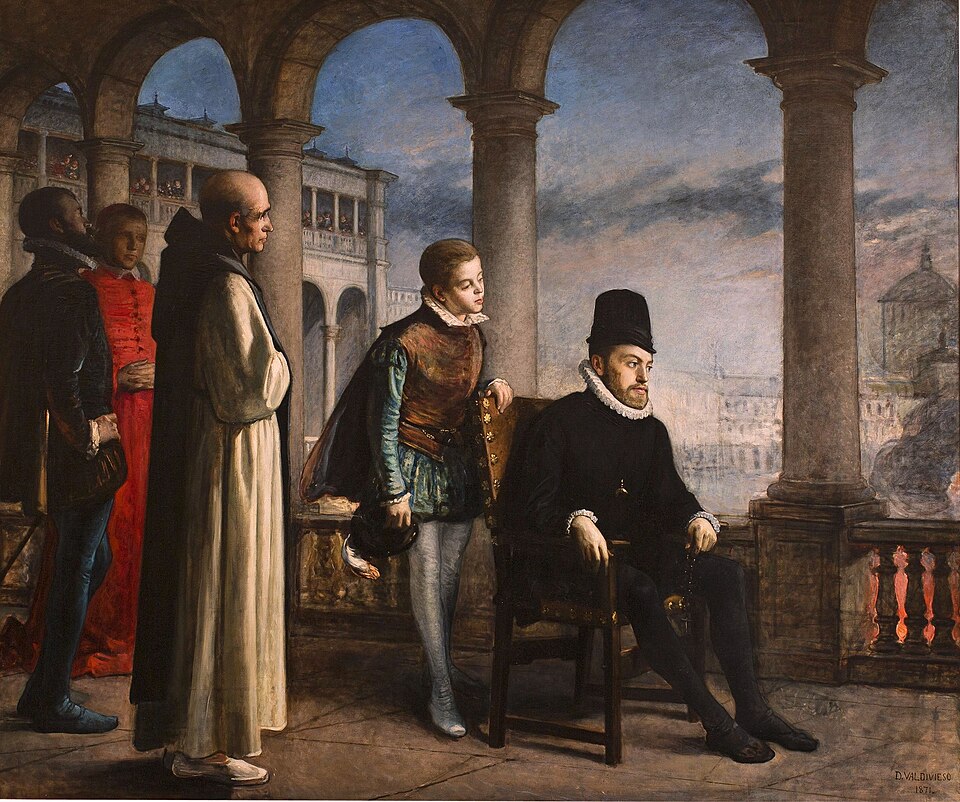
Philip II, King of Spain when Cervantes was alive, with his son contemplating an auto de Fe in Valladolid in which members of the newly discovered Protestant communities of Seville and Valladolid were burned.
What do I gain by reading Lope de Vega, the ‘monster of nature’ as Cervantes called him due to his abundant literary production, if due to circumstances he was unable to criticise the burning of Protestants in Valladolid? In other words: if someone fights the current paradigm, he also fights his art, be it Lope’s or Bach’s. Although we cannot blame the artist for his circumstances—in the 1590 edition of Cervantes’ first novel we can read on the title page Impresa con licencia de la Santa Inquisición (Printed with license from the Holy Inquisition)—the priest of the sacred words sees little, if any, value coming from the pens of artists whose minds were chained to the worldview of the time.
The Spanish Visigoths had begun to interbreed since the 7th century (see William Pierce’s Who We Are). Compared to the already mixed ethnicity of the Spanish a thousand years later, only the defeat of the Invincible Armada by Elizabeth’s England tipped the balance to a more Aryan side of Europe. Although the English were also infected with Christian ethics and capable of bringing mixed couples to the marriage altar, by the time of Cervantes and Shakespeare their ‘ethics’ hadn’t metastasized to the incredible anti-white levels we see in today’s UK.
In this new series I will be talking about other protagonists of the Christian civilisation from the point of view of the contemporary priest of the sacred words (in plain English, National Socialism after 1945).
Last day!
There is something I would like to say about a commenter on this last day of the year.
Exactly four years ago Irrelevant Nobody (I.N.) posted a comment that impressed me so much that I later cited it as an important entry. On 31 December the following year I.N. did the same: a comment also promoted as a special entry. He was one of the commenters to whom I dedicated in this now-dying year an entry in ‘On commenters of WDH’, where I mentioned that I.N. had sent me an email telling me that he was planning to commit suicide.
Sometime later he sent me another email telling me that he hadn’t committed suicide yet but had postponed that plan, and I have not received any more emails from this European, although I confess I haven’t written to him either.
It is not the first or the last time I have noticed that those who say the most lucid things have had mental health problems. It reminds me of what I wrote about my sister Corina in my books on my family, which I have promised myself I will start translating tomorrow. The chiaroscuros of the only honourable member of my family (may she rest in peace) were striking: enormous psychic insight and then dense darkness!
But in fairness to my sister and to commenters who have struggled with mental issues, we must concede that the entire West is in a state of madness at present. As far as the country that since 1945 has captained the West is concerned, on Saturday I mentioned some horrible murders. And yesterday I saw another YouTube video of an American who had decapitated his mother, and put her head in a bag which he left in a stranger’s truck.
I am convinced that to understand the folie en masse suffered by the West, it is imperative to understand the trauma model of mental disorders (which is why tomorrow, the first day of 2025, I will begin the formal translation of my trilogy). This is a model that is never taught in universities because Big Pharma dominates not only the psychiatric profession, but ideologically wields considerable influence in the faculties where clinical psychology is taught. The power of corporations today is such that we can only understand it if we compare it to the power that the Church wielded in the Middle Ages.
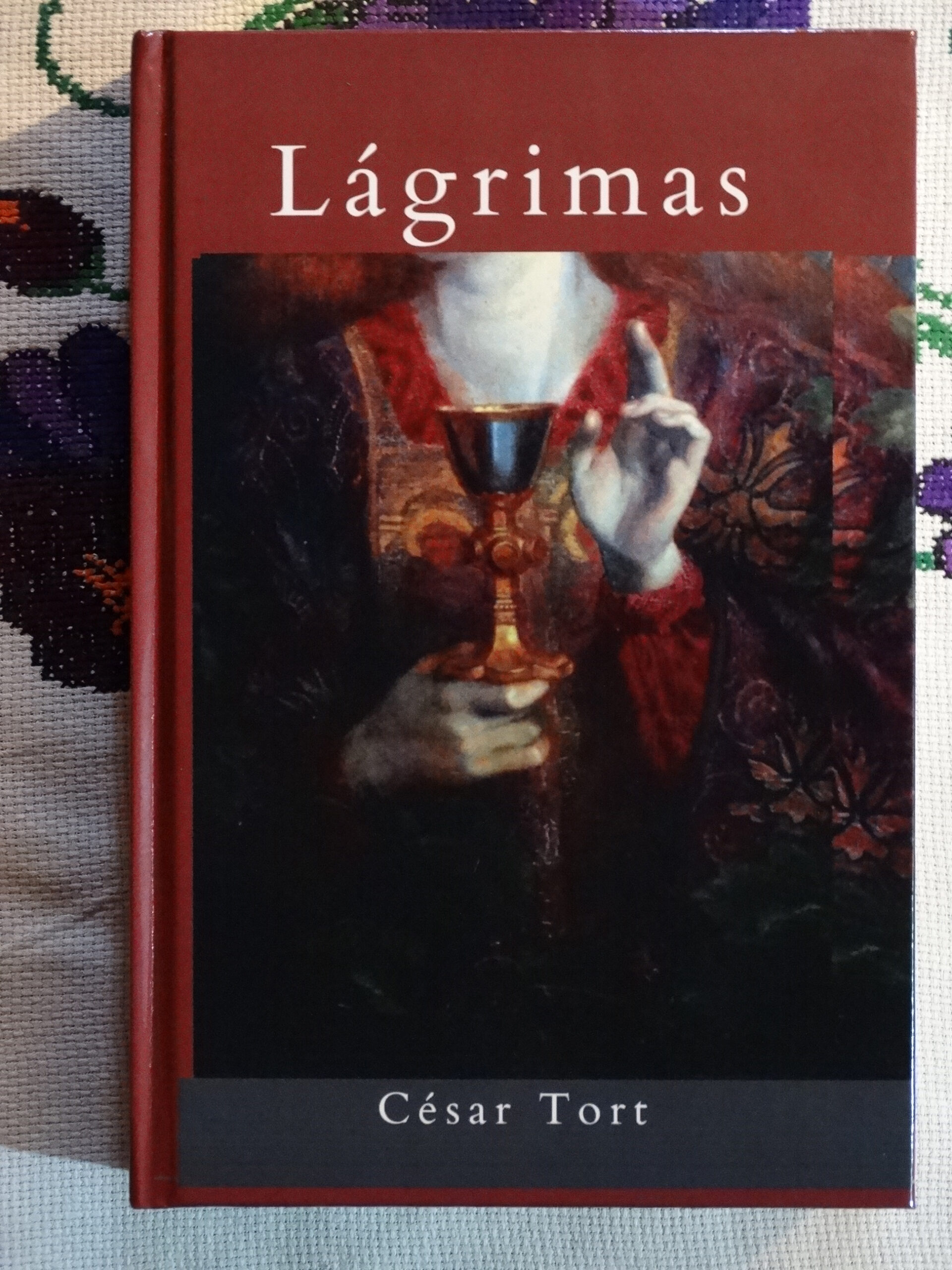
The last of my three autobiographical books, which I finished this year.
I hope that I.N. has survived his suicidal depression. I advised him to write his own trilogy (which made me see the light) and that he will return to his habit of commenting here on the last day of each year…
Turning the other cheek
In the excellent Russian film I saw based on this Dostoevsky novel, what stuck with me most was the slap given to the idiot prince (watch it here).

